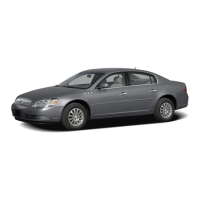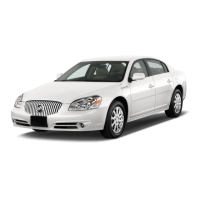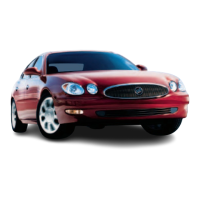Do you have a question about the Buick Lucerne 2007 and is the answer not in the manual?
Information on adjusting manual and power front seats, including lumbar and heating features.
Details on rear seating configurations and access to the trunk via pass-through.
Guidance on proper safety belt usage, why they work, and answers to common questions.
Information on selecting and using child restraints for older children, infants, and young children.
Overview of airbag types, deployment conditions, and what to expect after an airbag inflates.
Information on vehicle keys, including the ignition, doors, and glovebox lock functions.
Details on operating door locks, power locks, delayed locking, and security features.
Guidance on new vehicle break-in, ignition positions, starting the engine, and operating the transaxle.
Operation and cleaning instructions for rearview and side mirrors, including automatic dimming and OnStar.
System identification and programming instructions for garage door openers and security systems.
Instructions for operating the power sunroof, including express open, close, and vent functions.
Identification of main instrument panel components and their functions.
Explanation of how to use hazard warning flashers to alert others or signal a problem.
Operation of turn signals, lane changes, and headlamp controls.
Instructions for setting, resuming, and canceling cruise control, including safe usage guidelines.
Controls for headlamps, parking lamps, taillamps, and fog lamps, including automatic operation.
How to adjust the brightness of the instrument panel lights and control courtesy lamps.
Explanation of how the vehicle manages electrical power to optimize battery performance and life.
Description of the URPA system, its operation, limitations, and safety precautions.
Operation of the climate control system for heating, cooling, and ventilation.
Explanation of vehicle warning lights, gages, and indicators for system status and potential problems.
Overview of the instrument panel cluster, including warning lights and gages.
Information on the DIC system, controls, displays, and customization options.
Essential advice for safe driving, emphasizing anticipation and hazard awareness.
Information on the effects of alcohol on driving ability and legal limits.
Explanation of braking actions, perception and reaction times, and stopping distances.
How the ABS system works to prevent braking skids and what the warning light signifies.
How the TCS limits wheel spin in slippery conditions, and its interaction with cruise control.
Details on the StabiliTrak® system for maintaining directional control in difficult driving.
Tips for safely passing other vehicles on two-lane highways.
Information on what to do if control is lost, including skidding and emergency steering.
Tips for driving safely in wet conditions, including hydroplaning and brake precautions.
Rules and advice for driving safely on freeways, including merging and exiting.
Tips for preparing and driving safely during winter conditions.
Guidelines for determining correct load limits and avoiding vehicle damage from overloading.
Essential safety rules and procedures for towing a trailer, including equipment and weight considerations.
Information on recommended service, genuine GM parts, and accessory modifications.
Details on recommended gasoline types, octane ratings, and additives for optimal performance.
Guidance on inspecting engine components, fluids, and the air cleaner/filter.
Information on checking engine oil levels, adding oil, and the engine oil life system.
Details on the cooling system, coolant types, and adding coolant to the recovery tank or radiator.
Information on brake fluid, brake wear indicators, and replacing brake system parts.
Information on the maintenance-free battery, its location, and safety precautions for handling.
Step-by-step instructions for safely jump-starting the vehicle's battery.
Procedure for adjusting the vertical aim of headlamps, including aiming specifications.
Instructions for replacing exterior bulbs, including taillamps and sidemarker lamps.
Guidance on inspecting and replacing windshield wiper blades.
Information on tire maintenance, including proper inflation, wear, and replacement.
Explanation of the information found on tire sidewalls, including tire size and construction.
Importance of correct tire pressure and the consequences of under- or over-inflation.
How the TPMS works, alerts for low pressure, and malfunction indicators.
Recommendations for tire inspection intervals and rotation patterns for uniform wear.
Indicators for replacing tires, including treadwear indicators and damage signs.
Guidelines for selecting replacement tires, including TPC Spec ratings and tire construction.
Impact of using different tire/wheel sizes on vehicle performance and safety systems.
Explanation of UTQG ratings for treadwear, traction, and temperature performance.
Importance of proper alignment and balance for tire life and vehicle performance.
When to replace wheels and the proper procedure for replacement.
What to expect and do if a tire blowout or flat occurs while driving.
Step-by-step instructions for safely changing a flat tire using the vehicle's jack.
Proper procedures for storing the flat tire and tools after changing a tire.
Information on the proper use, limitations, and maintenance of the compact spare tire.
Guidelines for cleaning and maintaining the vehicle's interior surfaces.
Best practices for washing the vehicle's exterior to preserve paint finish, gloss, and durability.
Cleaning and care instructions for aluminum and chrome-plated wheels and trim.
Importance of proper body repair and anti-corrosion material application.
How to remove corrosive materials from the underbody to prevent rust.
Identifying and repairing paint damage caused by chemical fallout.
Locating and understanding the Vehicle Identification Number (VIN) and service parts label.
Information on add-on electrical equipment, power windows, and circuit protection.
How fuses and circuit breakers protect the vehicle's electrical circuits.
Location and identification of fuses in the underhood fuse block.
Location of the rear fuse block and procedure to remove the rear seat cushion.
Approximate capacities for fluids and specifications for engine components.
Introduction to maintenance, requirements, and the vehicle's impact on the environment.
Guidance on how to use the maintenance schedule based on driving habits and conditions.
Details on services required based on mileage or time intervals, including engine oil changes.
Services to be performed at specific mileage intervals, such as fuel system inspection.
Regular checks and services that owners can perform to maintain vehicle condition.
List of recommended fluids, lubricants, and their part numbers for vehicle service.
Part numbers for common maintenance items like air filters, oil filters, and spark plugs.
Diagrams illustrating the routing of engine drive belts for V6 and V8 engines.
A log to record scheduled services, dates, and performed services.
Procedure for resolving concerns, contact information for assistance, and required vehicle details.
How to report vehicle safety defects to the U.S. Government, Canadian Government, and General Motors.
Information on ordering service manuals and technical service bulletins for GM vehicles.
Explanation of vehicle computer modules, data recording, and privacy concerns.
Information on OnStar services, terms, conditions, and data collection.
Usage of the navigation system and information on stored data and deletion.
Explanation of RFID technology used for vehicle functions like tire pressure monitoring and security.
Information on adjusting manual and power front seats, including lumbar and heating features.
Details on rear seating configurations and access to the trunk via pass-through.
Guidance on proper safety belt usage, why they work, and answers to common questions.
Information on selecting and using child restraints for older children, infants, and young children.
Overview of airbag types, deployment conditions, and what to expect after an airbag inflates.
Information on vehicle keys, including the ignition, doors, and glovebox lock functions.
Details on operating door locks, power locks, delayed locking, and security features.
Guidance on new vehicle break-in, ignition positions, starting the engine, and operating the transaxle.
Operation and cleaning instructions for rearview and side mirrors, including automatic dimming and OnStar.
System identification and programming instructions for garage door openers and security systems.
Instructions for operating the power sunroof, including express open, close, and vent functions.
Identification of main instrument panel components and their functions.
Explanation of how to use hazard warning flashers to alert others or signal a problem.
Operation of turn signals, lane changes, and headlamp controls.
Instructions for setting, resuming, and canceling cruise control, including safe usage guidelines.
Controls for headlamps, parking lamps, taillamps, and fog lamps, including automatic operation.
How to adjust the brightness of the instrument panel lights and control courtesy lamps.
Explanation of how the vehicle manages electrical power to optimize battery performance and life.
Description of the URPA system, its operation, limitations, and safety precautions.
Operation of the climate control system for heating, cooling, and ventilation.
Explanation of vehicle warning lights, gages, and indicators for system status and potential problems.
Overview of the instrument panel cluster, including warning lights and gages.
Information on the DIC system, controls, displays, and customization options.
Essential advice for safe driving, emphasizing anticipation and hazard awareness.
Information on the effects of alcohol on driving ability and legal limits.
Explanation of braking actions, perception and reaction times, and stopping distances.
How the ABS system works to prevent braking skids and what the warning light signifies.
How the TCS limits wheel spin in slippery conditions, and its interaction with cruise control.
Details on the StabiliTrak® system for maintaining directional control in difficult driving.
Tips for safely passing other vehicles on two-lane highways.
Information on what to do if control is lost, including skidding and emergency steering.
Tips for driving safely in wet conditions, including hydroplaning and brake precautions.
Rules and advice for driving safely on freeways, including merging and exiting.
Tips for preparing and driving safely during winter conditions.
Guidelines for determining correct load limits and avoiding vehicle damage from overloading.
Essential safety rules and procedures for towing a trailer, including equipment and weight considerations.
Information on recommended service, genuine GM parts, and accessory modifications.
Details on recommended gasoline types, octane ratings, and additives for optimal performance.
Guidance on inspecting engine components, fluids, and the air cleaner/filter.
Information on checking engine oil levels, adding oil, and the engine oil life system.
Details on the cooling system, coolant types, and adding coolant to the recovery tank or radiator.
Information on brake fluid, brake wear indicators, and replacing brake system parts.
Information on the maintenance-free battery, its location, and safety precautions for handling.
Step-by-step instructions for safely jump-starting the vehicle's battery.
Procedure for adjusting the vertical aim of headlamps, including aiming specifications.
Instructions for replacing exterior bulbs, including taillamps and sidemarker lamps.
Guidance on inspecting and replacing windshield wiper blades.
Information on tire maintenance, including proper inflation, wear, and replacement.
Explanation of the information found on tire sidewalls, including tire size and construction.
Importance of correct tire pressure and the consequences of under- or over-inflation.
How the TPMS works, alerts for low pressure, and malfunction indicators.
Recommendations for tire inspection intervals and rotation patterns for uniform wear.
Indicators for replacing tires, including treadwear indicators and damage signs.
Guidelines for selecting replacement tires, including TPC Spec ratings and tire construction.
Impact of using different tire/wheel sizes on vehicle performance and safety systems.
Explanation of UTQG ratings for treadwear, traction, and temperature performance.
Importance of proper alignment and balance for tire life and vehicle performance.
When to replace wheels and the proper procedure for replacement.
What to expect and do if a tire blowout or flat occurs while driving.
Step-by-step instructions for safely changing a flat tire using the vehicle's jack.
Proper procedures for storing the flat tire and tools after changing a tire.
Information on the proper use, limitations, and maintenance of the compact spare tire.
Guidelines for cleaning and maintaining the vehicle's interior surfaces.
Best practices for washing the vehicle's exterior to preserve paint finish, gloss, and durability.
Cleaning and care instructions for aluminum and chrome-plated wheels and trim.
Importance of proper body repair and anti-corrosion material application.
How to remove corrosive materials from the underbody to prevent rust.
Identifying and repairing paint damage caused by chemical fallout.
Locating and understanding the Vehicle Identification Number (VIN) and service parts label.
Information on add-on electrical equipment, power windows, and circuit protection.
How fuses and circuit breakers protect the vehicle's electrical circuits.
Location and identification of fuses in the underhood fuse block.
Location of the rear fuse block and procedure to remove the rear seat cushion.
Approximate capacities for fluids and specifications for engine components.
Introduction to maintenance, requirements, and the vehicle's impact on the environment.
Guidance on how to use the maintenance schedule based on driving habits and conditions.
Details on services required based on mileage or time intervals, including engine oil changes.
Services to be performed at specific mileage intervals, such as fuel system inspection.
Regular checks and services that owners can perform to maintain vehicle condition.
List of recommended fluids, lubricants, and their part numbers for vehicle service.
Part numbers for common maintenance items like air filters, oil filters, and spark plugs.
Diagrams illustrating the routing of engine drive belts for V6 and V8 engines.
A log to record scheduled services, dates, and performed services.
Procedure for resolving concerns, contact information for assistance, and required vehicle details.
How to report vehicle safety defects to the U.S. Government, Canadian Government, and General Motors.
Information on ordering service manuals and technical service bulletins for GM vehicles.
Explanation of vehicle computer modules, data recording, and privacy concerns.
Information on OnStar services, terms, conditions, and data collection.
Usage of the navigation system and information on stored data and deletion.
Explanation of RFID technology used for vehicle functions like tire pressure monitoring and security.
| Brand | Buick |
|---|---|
| Model | Lucerne 2007 |
| Category | Automobile |
| Language | English |












